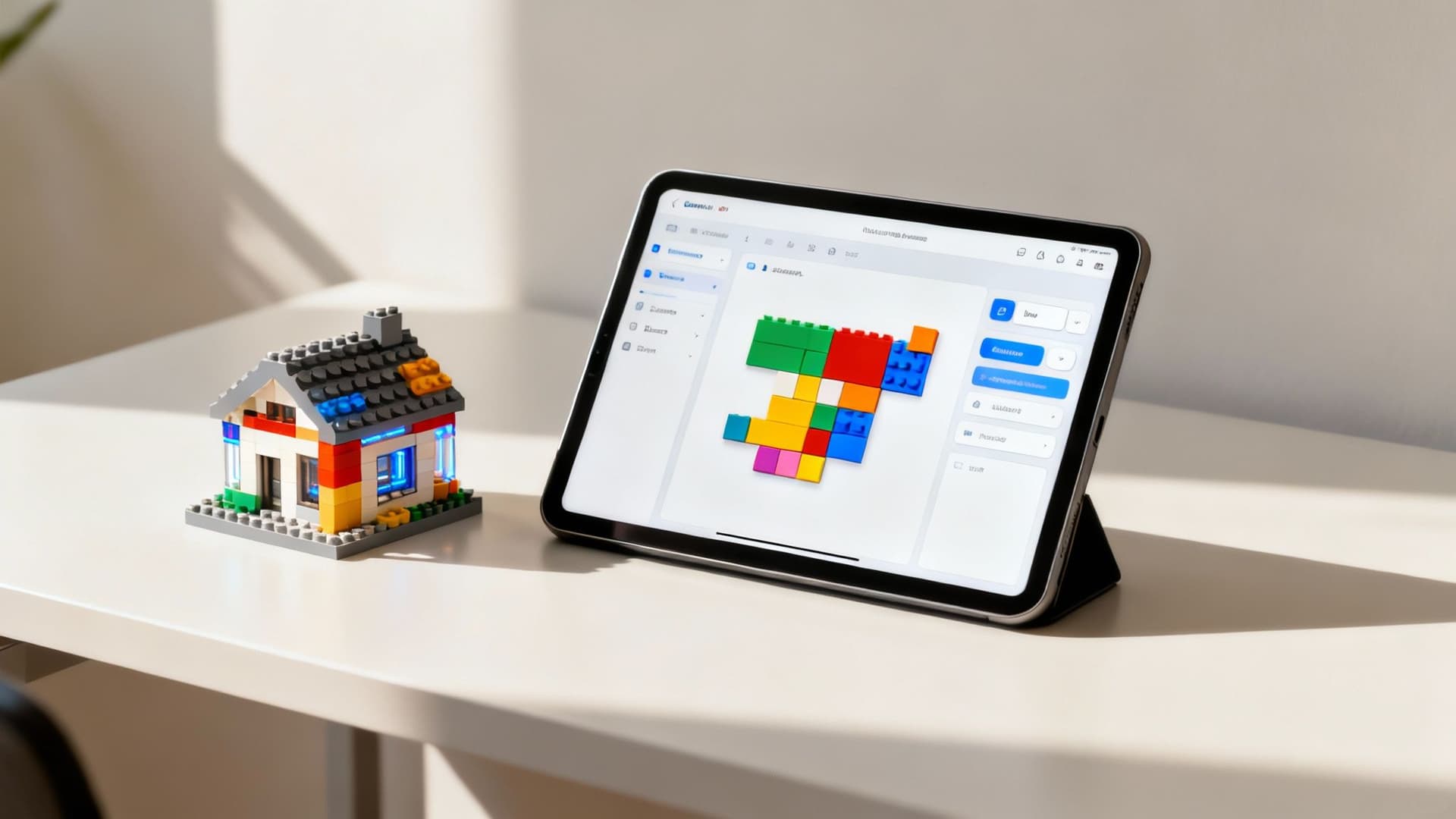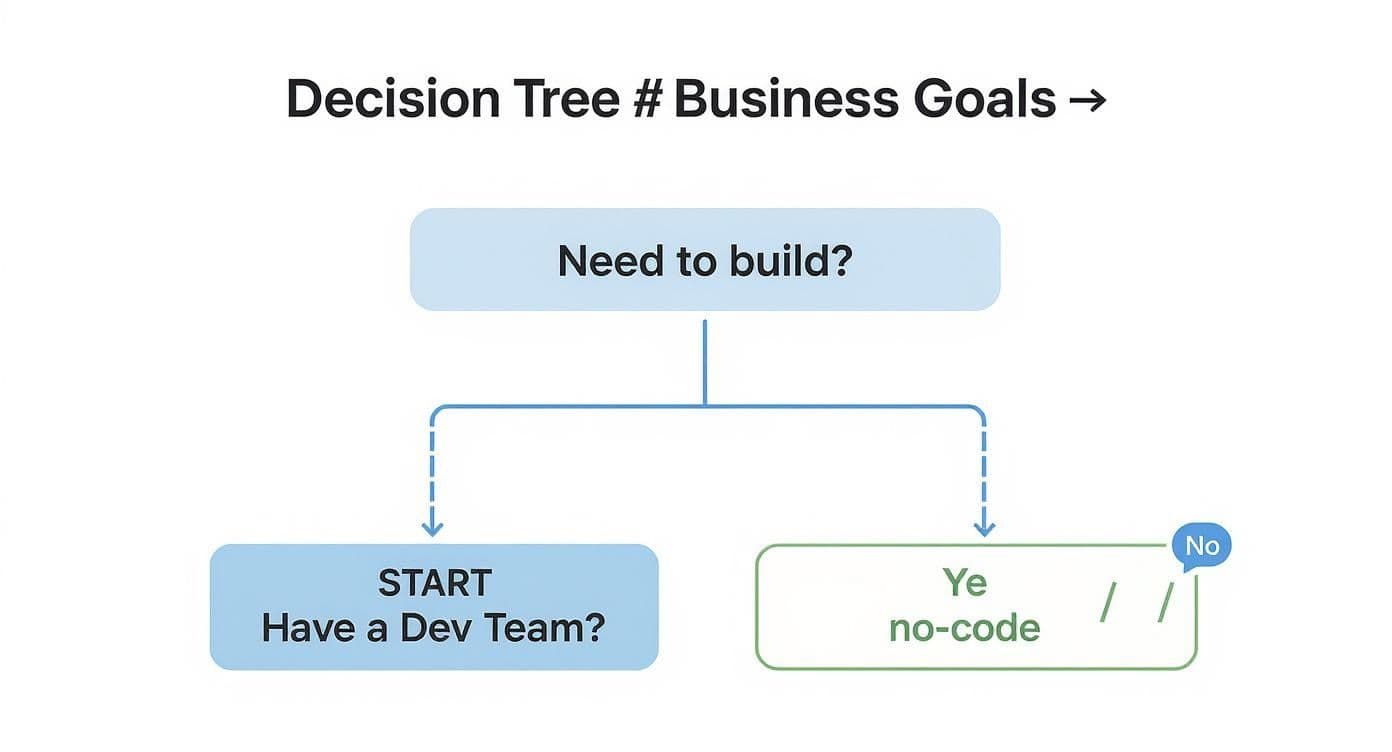Explore what is no-code development and learn to build powerful apps and websites visually, no coding skills required, and launch faster.
November 15, 2025 (1d ago)
What is no-code development? Build Apps Fast, No Coding
Explore what is no-code development and learn to build powerful apps and websites visually, no coding skills required, and launch faster.
← Back to blog
Title: What Is No-Code Development? Build Apps Fast
Summary: Learn how no-code development lets non‑developers build apps and websites faster, cut costs, and automate workflows using visual, drag‑and‑drop tools.
Introduction: No-code development lets anyone build powerful apps and websites using visual, drag‑and‑drop tools. You don’t need to write code to launch prototypes, automate workflows, or solve business problems quickly.
Content:
Imagine building a house with high‑tech LEGO blocks instead of lugging around lumber and mixing concrete. That’s the basic idea behind no‑code development. It’s a way to create fully functional websites and applications using a visual, drag‑and‑drop interface, turning just about anyone into a creator.
What Is No‑Code Development, Really?
At its heart, no‑code is a method of building software that sidesteps traditional programming. Instead of writing lines of Python or JavaScript, you work within a visual environment. These platforms let you piece together applications by dragging and dropping pre‑built components and then tweaking their behavior through simple menus and settings.
Think of it like this: a professional chef cooking from scratch is like a traditional coder. A no‑code developer is like someone using a high‑end meal kit service. The meal kit gives you all the pre‑measured ingredients and clear, visual instructions, letting you whip up a gourmet meal without ever attending culinary school. No‑code platforms do the same, providing the essential building blocks for powerful software.

The Rise of the Citizen Developer
This new way of building has given rise to a new type of creator: the citizen developer. These aren’t software engineers; they’re the people on the front lines of business—marketers, project managers, HR professionals, and entrepreneurs. They know their business challenges inside and out but don’t have formal coding training.
“No‑code breaks down the old barriers to technology. It puts the power to build software directly into the hands of those who need it most, closing the gap between a great idea and a working solution.”
And this isn’t just a niche trend; it’s a fundamental market shift. The global no‑code market hit $28.75 billion in 2024 and is projected to grow rapidly over the coming years1.
From Simple Websites to Complex Business Tools
The variety of what you can build with no‑code is astounding. You can create everything from a basic landing page for a new product to sophisticated internal tools that run entire departments.
For example, a marketing agency could embed an interactive value estimator like the YouTube Channel Value Estimator on its site. That provides instant value to potential clients and captures high‑quality leads without a developer building the tool from scratch.
This is the real magic of no‑code: it lets you solve tangible business problems quickly and often without a huge budget. Understanding development costs helps you see how impactful this can be; you can compare tools like the Digital Business Valuation Tool when estimating returns.
The Real‑World Benefits of Going No‑Code
So why is everyone talking about no‑code? It’s not just another tech trend; it’s a shift in how businesses solve problems. The main benefits are speed, cost savings, and empowering teams to build what they need.
Speed is a major advantage. Traditional software development can take months or longer to move from idea to launch. No‑code platforms let you create a working prototype or an MVP in days or weeks. That means you can test ideas with real users quickly and iterate based on real feedback.
Driving Down Costs and Boosting Profitability
Hiring skilled developers is expensive. No‑code platforms reduce the need for large engineering teams for every project.
Instead of paying thousands to build a custom quoting tool, a sales team could embed a calculator or estimator into an internal dashboard using a tool like the Consulting Rates Estimator. That cuts development costs and reduces manual errors that hurt margins.
A recent market analysis found that a large share of businesses now rely on low‑code and no‑code tools to speed work and cope with developer shortages2.
“No‑code puts problem‑solving power back into the hands of the people who face the problems every day.”
Empowering Your Team to Innovate
No‑code turns business experts—marketers, operations managers, and project leads—into creators. When your team can build its own tools, innovation doesn’t get stuck in an IT queue.
Examples:
- A marketing manager can build a workflow to automatically nurture new leads.
- An HR specialist can design a custom portal for onboarding new hires.
- A project lead can create a dashboard that tracks metrics in real time.
A small business owner needing financing estimates could use a simple embedded calculator like the Mortgage Calculator for quick, reliable answers. These tools let people automate work and focus on higher‑value tasks.
No‑Code vs. Low‑Code: Which to Choose
You’ll often hear “no‑code” and “low‑code” together, but they serve different needs.
No‑code is like a high‑end LEGO set: ready‑made pieces and a visual guide let non‑technical users build quickly. Low‑code is like a professional model kit: it speeds development but assumes some coding skill for custom parts.
Key Differences
- Who It’s For: No‑code—business users and “citizen developers.” Low‑code—professional developers and IT teams.
- Learning Curve: No‑code is gentle; you can launch simple apps in hours. Low‑code requires programming knowledge.
- Flexibility: No‑code is fast but limited to platform features. Low‑code allows custom code for unique requirements.

Choosing the Right Approach
If you need an internal dashboard or a lead‑gen quiz, no‑code is ideal. If you’re building a complex enterprise system that must connect legacy databases with specialized logic, low‑code or traditional development may be better.
For quick pricing tools and calculators, consider embedding a ready tool like the Business Valuation Estimator to add immediate value without custom code.
How No‑Code Solves Everyday Business Problems
No‑code shines at fixing specific, everyday problems that used to require a developer or a painful spreadsheet.
Imagine a sales team with inconsistent pricing. Instead of a long, costly custom project, a sales manager can build a simple quoting app on a no‑code platform in a day.
From Manual Workflows to Automated Solutions
No‑code eliminates repetitive tasks. Examples:
- Automating lead nurturing with workflows that send follow‑ups based on actions.
- Creating secure client portals so teams stop emailing files back and forth.
- Building custom dashboards that pull data from multiple sources in real time.
Embedding a tool like the Consulting Rates Estimator in a proposal app helps ensure projects are priced for profit and removes spreadsheet errors.
“No‑code isn’t just about building apps; it’s about giving your team the power to build their own solutions.”
Boosting Profitability with Smart Tools
No‑code helps create better customer experiences and smarter decision tools. A financial advisor embedding a Business Valuation Estimator can capture leads and demonstrate expertise.
A SaaS startup could add a valuation estimator or business tool to investor pages to show clear, real‑time metrics without manual updates.
Integrating Smart Tools into Your No‑Code Apps
Smart no‑code strategies use pre‑built components where it makes sense. Why ask a developer to code complex formulas when you can embed a tested tool?

How Integration Drives Profitability
Embedding pre‑built calculators and estimators cuts guesswork and manual errors that shrink margins. For example:
- For sales teams: integrating a reliable estimator into a sales dashboard gives reps instant, accurate pricing.
- For agencies: adding a value estimator like the YouTube Channel Value Estimator to client portals demonstrates measurable results.
“Integrating specialized no‑code components is like adding a team of experts to your app without the overhead.”
Automating Workflows and Improving UX
Connecting forms to calculators and then to a CRM creates a smooth, hands‑off system that nurtures leads and frees your team for higher‑value work.
Your First Steps into No‑Code Development
Jumping into no‑code can feel big, but start with one real problem you already know well. Don’t try to build the next Facebook—solve a small, annoying inefficiency first.
Choosing Your Platform and Tools
Match the platform to your goal. Some builders excel at websites, others at dashboards or mobile apps. Where possible, plug in pre‑built components like the Mortgage Calculator or the Digital Business Valuation Tool to save time.
Learn by Doing
No‑code is learned by building. Start small: a simple internal calculator or a workflow automation. Iterate, improve, and scale from real results.
“Build a simple tool, see it solve a real problem, and you’ll quickly grasp the potential.”
Still Have Questions About No‑Code?
It’s normal to have questions about security, scaling, and limits. Here are common concerns addressed.
Is No‑Code Actually Secure?
Yes. Top‑tier no‑code platforms invest heavily in security, handling server‑side protection, encryption, and compliance so you can focus on functionality.
What Happens When My App Gets Popular? Can It Scale?
Modern no‑code platforms are built on cloud infrastructure designed to scale with usage, so they can support growth from dozens to thousands of users3.
So, What Can’t It Do?
No‑code isn’t magic. If you need highly specialized, proprietary features that aren’t available as pre‑built blocks, you may need low‑code or custom development. Most platforms offer integrations to extend capabilities, and for deeply custom logic you can combine no‑code with developer help.
Ready to try no‑code? With tools like the YouTube Channel Value Estimator and the Business Valuation Estimator, you can add instant value to your site and start solving real problems today.
Start building your free tool today
Frequently Asked Questions
Q: What is no‑code best used for?
A: No‑code is ideal for internal tools, landing pages, lead‑generation widgets, and automations—projects where speed and low cost matter most.
Q: How fast can I launch something useful?
A: Many teams build a working prototype or MVP in days or weeks, depending on complexity.
Q: When should I choose low‑code or custom development instead?
A: Choose low‑code or custom development when you need deep integrations, unique performance requirements, or highly specialized business logic.
Ready to Build Your Own Tools for Free?
Join hundreds of businesses already using custom estimation tools to increase profits and win more clients